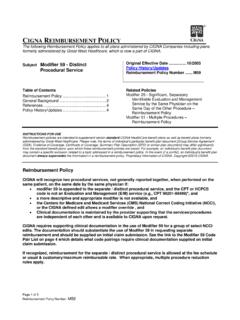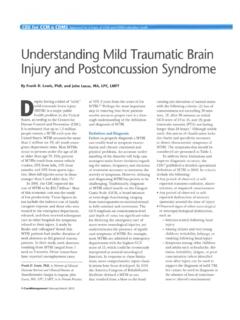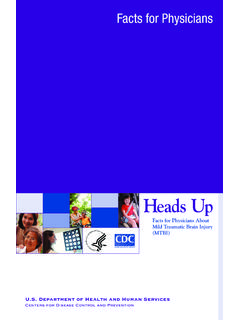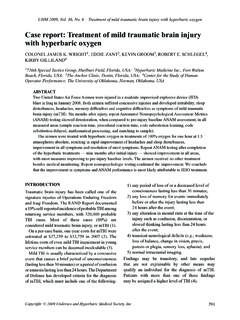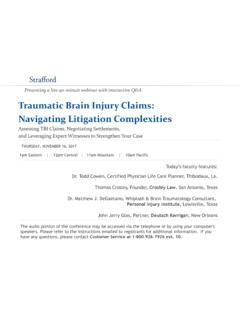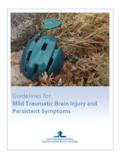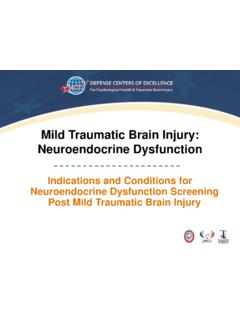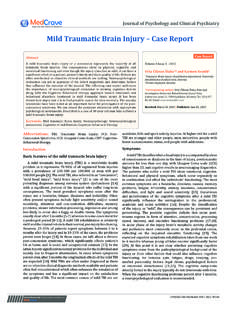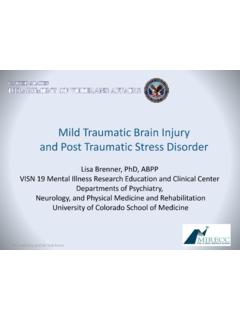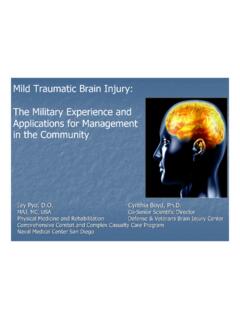Transcription of Recommendations for Diagnosing a Mild Traumatic Brain ...
1 Recommendations for Diagnosing a mild Traumatic Brain injury :A National Academy of Neuropsychology Education PaperRonald M. Ruffa, b,*, Grant L. Iversonc, d, Jeffrey T. Barthe, Shane S. Bushf, Donna K. Brosheke,and the NAN Policy and Planning Committee aSan Francisco Clinical Neurosciences, San Francisco, CA, USAbUniversity of California San Francisco, San Francisco, CA, USAcUniversity of British Columbia, Vancouver, BC, CanadadBritish Columbia Mental Health and Addiction Services, Vancouver, BC, CanadaeUniversity of Virginia School of Medicine, Charlottesville, VA, USAfLong Island Neuropsychology, , Lake Ronkonkoma, NY, USAA ccepted November 2008 AbstractA special interest group of the American Congress of Rehabilitation Medicine [ACRM; mild Traumatic Brain injury Committee.]
2 (1993).Definition of mild Traumatic Brain of Head Trauma Rehabilitation, 8 (3), 86 87.] was the first organized interdisciplinarygroup to advocate four specific criteria for the diagnosis of a mild Traumatic Brain injury (TBI). More recently, the World HealthOrganization (WHO) Collaborative Center Task Force on mild Traumatic Brain injury [Carroll, L. J., Cassidy, J. D., Holm, L., Kraus, J., &Coronado, V. G. (2004). Methodological issues and research Recommendations for mild Traumatic Brain injury : the WHO CollaboratingCentre Task Force on mild Traumatic Brain of Rehabilitation Medicine, (Suppl. 43), 113 125.] conducted a comprehensivereview of the definitions utilized in evidence-based studies with mild TBI patients.
3 Based on this review, the WHO task force maintainedthe same four criteria but offered two modifications. The similarities and differences between these two definitions are discussed. Theauthors of the ACRM and the WHO definitions do not provide guidelines or specific Recommendations for Diagnosing the four , we provide Recommendations for assessing loss of consciousness, retrograde and post- Traumatic amnesia, disorientation and confusionas well as clarification of the neurologic signs that can be indicative of a diagnosis of mild TBI. Finally, confounding factors mentioned inboth definitions that should exclude a mild TBI diagnosis are : mild Traumatic Brain injury ; Neuropsychology; Treatment; Assessment; Head injuryIntroductionMild Traumatic Brain injury (TBI) occurs frequently.
4 Across all severity levels of TBI, the Centers for Disease Control andPrevention (2006) estimated that approximately 2% of the population is living with some degree of disability as a result ofa TBI. Of the annual incidence of million TBIs, it is estimated that approximately 80% are of mild severity, with theremaining 20% split more or less evenly between moderate and severe TBIs (Kraus, McArthur, Silverman, & Jayaraman,1996). Given that past incidence data for mild TBIs were primarily derived from patients evaluated in hospital emergency*Corresponding author at: 909 Hyde Street, Suite 620, San Francisco, CA 94109, USA. Tel.: 1-415-771-7833; fax: ( Ruff). The Policy and Planning Committee of the National Academy of Neuropsychology (NAN) is charged with writing position and educational papers regard-ing important issues that affect the profession of Neuropsychology.
5 Possible topics for the papers are suggested by the NAN Board of Directors, members of theNAN Policy and Planning Committee, or individual Academy members. Primary authors are identified and approved by the NAN Policy and PlanningCommittee. These authors can come from within or outside the Policy and Planning Committee. Selected outside reviewers provide extensive peer reviewfor all papers. All topics and the final paper submissions are reviewed and approved by the NAN Board of Directors. This process of review and approvaltakes the place of the system of peer review typically conducted by the Editor and Editorial Board of this of Clinical Neuropsychology 24 (2009) 3 10#The Author 2009. Published by Oxford University Press on behalf of the National Academy of Neuropsychology.
6 All rights permissions, please e-mail: Advance Access publication on 17 March 2009rooms, these incidence rates are underestimates because the majority of persons who sustain a mild TBI either consult theirprimary care physician days after the injury or seek no care at all (Kay, Newman, Cavallo, Ezrachi, & Resnick, 1992;Langlois et al., 2003; Mellick, Gerhart, & Whiteneck, 2003; Sosin, Sniezek, & Thurman, 1996). Hence, the 1998 NationalInstitute of Health (NIH) Consensus statement concluded that mild TBIs were underdiagnosed (NIH, 1998).In comparison with moderate and severe Brain injuries, mild TBIs are often more challenging to diagnose. This is due torapid resolution of acute signs and symptoms ( , loss of consciousness [LOC], post- Traumatic amnesia [PTA], disorientation,and confusion) and the typical absence of objective evidence of injury on neuroimaging.
7 The lack of a universally agreed defi-nition of mild TBI contributes to this diagnostic challenge. Moreover, the lack of guidelines for assessing specific diagnosticcriteria can lead to diagnostic disagreements. To better understand and serve this patient population, the National Academy ofNeuropsychology s Policy and Planning Committee wrote this paper to provide Recommendations for Diagnosing a mild American Congress of Rehabilitation Medicine and World Health Organization DefinitionsThe American Congress of Rehabilitation Medicine (ACRM; mild Traumatic Brain injury Committee, 1993) was the firstorganized interdisciplinary group to advocate four specific criteria for the diagnosis of a mild TBI (Table 1). This ACRM defi-nition has been widely used, especially in the field of rehabilitation and neuropsychology.
8 With a focus on managing sports-related concussions, the American Academy of Neurology (1997) also published a definition of mild TBI (Table 2). For adetailed review of sports-related concussion, see the National Academy of Neuropsychology s recent position paper(Moser et al., 2007). For the purpose of the present paper, the term concussion is used synonymously with mild TBI. Eleven years after the ACRM definition was published, the World Health Organization (WHO) Collaborative Center TaskForce on mild Traumatic Brain injury (Carroll, Cassidy, Holm, Kraus, & Coronado, 2004) published a comprehensive reviewof definitions utilized in research studies and identified significant definitional discrepancies. For example, 62% of thedefinitions reviewed incorporated Glasgow Coma Scale (GCS) scores, yet the range of scores varied, including scores of13 15, 14 15, or only 15.
9 Similarly, although LOC or amnesia was required in some definitions, the duration of LOCvaried. Thus, the WHO task force concluded that the literature would greatly benefit by common criteria (p. 115).The WHO task force then advanced a standardized definition. In doing so, it acknowledged that the definition was derivedfrom the ACRM definition and was also similar to the definition proposed by the Centers for Disease Control and Prevention sMild TBI Working Group (Center for Disease Control and Prevention, 2003). The WHO task force operational definition isreprinted criteria for mild TBI by the American Congress of Rehabilitation Medicine Special Interest Group on mild Traumatic Brain InjuryA traumatically induced physiological disruption of Brain function, as manifested byat leastone of the following:any loss of consciousnessany loss of memory for events immediately before or after the accidentany alteration in mental state at the time of the accident ( , feeling dazed, disoriented, or confused) andfocal neurologic deficit(s) that may or may not be transientBut where the severity of the injury does not exceed the following.
10 Loss of consciousness of approximately 30 min or lessafter 30 min, an initial Glasgow Coma Scale score of 13 15 andpost- Traumatic amnesia not greater than 24 hrNote:Developed by the mild Traumatic Brain injury Committee of the Head injury Interdisciplinary Special Interest Group (1993).Table grading system by the American Academy of NeurologyGrade 1 Grade 2 Grade 3No LOCNo LOCLOC (seconds or minutes)Transient confusionTransient confusionSymptoms ( , headaches and dizziness) andmental status changes ( , befuddlement,inability to focus attention, or post-traumaticamnesia) resolve in less than 15 minSymptoms or mental status changes lastmore than 15 minLOC loss of Ruff et al. / Archives of Clinical Neuropsychology 24 (2009) 3 10 MTBI is an acute Brain injury resulting from mechanical energy to the head from external physical forces.
